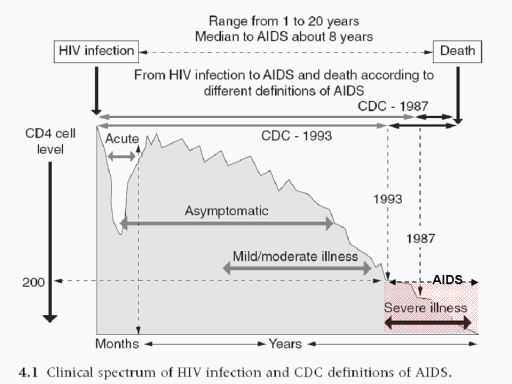| front |1 |2 |3 |4 |5 |6 |7 |8 |9 |10 |11 |12 |13 |14 |15 |16 |17 |18 |19 |20 |21 |22 |23 |24 |25 |26 |27 |28 |29 |30 |31 |32 |33 |review |
 |
This
figure from Chapter 4 of my book shows the different clinical stages
and estimated approximate intervals from acquisition of an HIV
infection to development of AIDS (according to different public
health surveillance definitions), and from AIDS to death.
HIV
infection is probably lifelong, and severe immune deficiency will
develop in about half of HIV-infected adults within 8 years after
infection.
As severe immune damage develops, the infected person
is susceptible to many opportunistic infections and cancers, and
these illnesses are the surrogate or indirect indicators of the
immunodeficiency due to HIV and collectively they constitute the
diagnosis of Acquired Immune Deficiency
Syndrome (AIDS).
Annual
progression rates from HIV infection to the development of AIDS is similar
in Haiti, Thailand, Uganda, and “Western” countries (median of 8 years).
Survival after the onset of AIDS is, in the absence of
anti-HIV treatment, short, and is usually less than 1 year in developing
countries.
The advent of effective drug treatment for HIV infection
during the mid-1990s has complicated the use of models that rely on a
standard median progression interval to AIDS! |